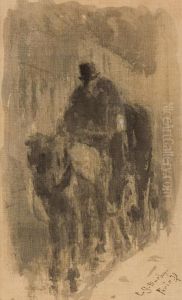Charles Green Bush Paintings
Charles Green Bush, commonly known as C.G. Bush, was an American illustrator and painter born on March 7, 1842, in Middletown, Rhode Island. Bush is best known for his work as an illustrator in prominent 19th-century magazines and his contributions to the field of graphic arts during the period.
Bush's early life was marked by an inclination towards the arts, and he pursued his passion by studying at the National Academy of Design in New York. His education in the arts laid the foundation for his distinctive style, which would later become recognizable in his illustrations and paintings.
During his career, Bush became a prolific illustrator, contributing to well-known publications such as Harper's Weekly, Scribner's Monthly, and The Atlantic Monthly. His illustrations often captured the essence of American life and society, reflecting the cultural and social dynamics of the time. Bush's work was characterized by its attention to detail, nuanced use of shading, and an ability to convey narrative and emotion, which made his images resonate with a broad audience.
In addition to his magazine work, Bush also illustrated a number of books, cementing his reputation as a skilled draftsman and storyteller through imagery. His book illustrations further showcased his aptitude for capturing character and setting, often enhancing the literary work with his visual interpretations.
Bush's talents were not confined to illustration; he was also an accomplished painter. His paintings typically featured landscapes, seascapes, and genre scenes, demonstrating his versatility and his appreciation for nature and everyday life. While his paintings may not have gained the same level of fame as his illustrations, they were well-regarded among his contemporaries.
Charles Green Bush passed away on September 2, 1929. Today, his work is part of the collections of various institutions, and he is remembered for his contributions to American art, particularly in the realm of illustration. His legacy lives on through the images he created, which continue to offer insight into the society and culture of his time.
